The Intricacies of Naval Warfare in Strategy Games
22 July 2025
Ahoy, gamers and strategy enthusiasts! Let’s set sail on a journey into the deep blue and talk about something that has fascinated generations of tacticians: naval warfare. If you’ve ever found yourself at the helm of a fleet of warships, staring at a digital ocean rife with opportunities and threats, you know exactly how intense and rewarding naval combat in strategy games can be. But what makes it so gripping? Why do so many of us gravitate toward commanding fleets in video games?
In this article, we’re going to dive headfirst into the intricacies of naval warfare in strategy games. From the thrill of planning the perfect ambush to the nail-biting tension of defending your coastline, I promise it’s going to be a splash-worthy read. So buckle up, captains, because the high seas of strategy await!
Naval Warfare: The Heart of Strategy on Water
Picture this: you’re in the middle of a campaign. Your land forces hold the line, but your enemy’s navy lurks just beyond the fog of war. Suddenly, your supply lines are attacked, your coastal cities bombarded, and your plans thrown into chaos. It’s in that moment when it hits you—controlling the seas can make or break your strategy.This is the magic of naval warfare in strategy games. It forces you to think beyond the confines of land-based battles and adds an entirely new layer to your tactics. Naval combat is fluid (pun totally intended). Unlike ground-based warfare, where terrain and chokepoints dictate movement, naval battles shift dynamically. You’re dealing with wide-open spaces, unpredictable weather effects, and the constant danger of ambushes.
The Unique Appeal of Naval Warfare
So, what makes naval warfare stand out from other types of in-game combat? For starters, it combines strategy with positioning and a bit of psychology. Let me explain.1. It’s All About Positioning
Naval combat is like a deadly game of chess—except your pawns are battleships, and your queen is an aircraft carrier. Every move matters. Position your fleet wrong, and you could lose half your ships before the battle even begins. There’s something inherently satisfying about maneuvering your destroyers and battleships into the perfect formation, then unleashing absolute chaos on the enemy.A poorly executed naval maneuver can leave you feeling like you’re up the creek without a paddle, while a well-timed flank can make you feel like a strategic genius.
2. Resource Management at Sea
Unlike land-based units that can usually resupply fairly easily, naval fleets have unique logistical needs. Games like Hearts of Iron IV and Total War: Empire emphasize this by making you manage fuel, ammunition, and even repair capabilities. It’s not just about sending ships into battle; it’s about sustaining them. That layer of resource management adds a delicious complexity.3. The Thrill of the Chase
There’s nothing quite like hunting down an enemy carrier group that’s been harassing your coastline for weeks. Tracking fleets, interpreting radar data, setting up ambushes—it’s like being in a high-stakes game of cat and mouse. Games like World of Warships and Command: Modern Operations capture this feeling perfectly. These moments make naval warfare feel alive, unpredictable, and deeply engaging.
Naval Warfare Staples: Ships, Submarines, and Carriers
Let’s talk about the real stars of the show—the ships themselves. Naval warfare in strategy games is often defined by the types of vessels you command. Each class has a unique role to play, and learning how to use them effectively is key to ruling the waves.1. Destroyers: The Agile Workhorses
Destroyers are quick and versatile, often tasked with escort duties, scouting, and anti-submarine warfare. Think of them as the Swiss Army knives of the sea—small, reliable, and capable of dealing with almost anything. But don’t get cocky; they crumble like a sandcastle under heavy fire.2. Battleships: The Heavy Hitters
Ah, the battleships. These bad boys bring the firepower, boasting massive guns that can obliterate smaller vessels in seconds. However, they’re slow and vulnerable to faster ships and submarines. Treat them like the tanks of the sea—powerful but needing support.3. Submarines: Silent but Deadly
Submarines are the ultimate wildcard. They’re perfect for stealth missions, ambushes, and disrupting supply lines. However, they’re delicate and require careful handling. When used correctly, they can single-handedly turn the tide of war.4. Aircraft Carriers: The Floating Airbases
Carriers are arguably the most influential units in modern naval warfare. They allow you to project power far beyond your fleet’s immediate location. But don’t let their strength fool you—losing a carrier can be a devastating blow to your strategy. Protect these like your life depends on it (because it usually does).
Iconic Naval Strategy Games You Should Play
If you’re new to naval warfare in strategy games, here are a few titles that showcase its depth and excitement.1. Total War: Empire/Total War: Napoleon
These games offer a historical look at naval combat, complete with ship-to-ship broadsides and intricate fleet management. Nothing beats the exhilaration of lining up a perfect broadside and watching your cannons obliterate an enemy frigate.2. Hearts of Iron IV
HOI4 is a dream for history and strategy buffs. It’s a grand strategy game where naval warfare plays a crucial role in global domination. You’ll need to manage everything from convoy protection to massive carrier battles in the Pacific.3. World of Warships
If you prefer a more hands-on experience, World of Warships puts you right in the captain’s chair. It’s an online multiplayer game that emphasizes individual ship tactics, teamwork, and quick decision-making.4. Command: Modern Operations
For those who crave ultra-realistic simulations, this game is top-tier. It goes beyond just controlling ships—you’ll manage radar systems, sonar, and even electronic countermeasures. The depth is mind-blowing.Naval Warfare Strategies That’ll Keep You Afloat
You didn’t think I’d just talk about how cool naval combat is without sharing some pro tips, did you? Here are some tried-and-tested strategies to dominate the seas in your favorite games.1. Control the Chokepoints
Just like in real life, geography matters. Funnel your enemies into chokepoints where they’ll have limited room to maneuver. It’s like herding sheep into a pen, only your pen is full of torpedoes and artillery shells.2. Scout, Scout, Scout
Information is power. Use your destroyers, reconnaissance planes, or even submarines to gather intel. Knowing where the enemy fleet is can make the difference between victory and a watery grave.3. Diversify Your Fleet
Don’t put all your eggs in one basket. A balanced fleet with a mix of ship types is far more effective than an armada of battleships. Think of it like a well-rounded RPG party—you need tanks, DPS, and support.4. Keep Your Supply Lines Safe
Don’t get so caught up in attacking that you forget to defend. Losing your supply lines can cripple your war effort faster than you can say “sunk cost.”Why We Love Naval Warfare in Games
At the end of the day, naval warfare in strategy games is about more than just sinking ships. It’s about outsmarting your opponent, making bold moves, and adapting to ever-changing circumstances. There’s a certain romance to commanding a fleet, navigating treacherous waters, and carving your name into the annals of history. Plus, let’s be real—watching a battleship explode in a glorious fireball? Chef’s kiss.So the next time you fire up a strategy game and see the shimmering expanse of the ocean, don’t hesitate. Dive in, take the helm, and show the world that your tactical prowess knows no bounds.
all images in this post were generated using AI tools
Category:
Strategy GamesAuthor:

Jack McKinstry
Discussion
rate this article
1 comments
Seth McLaury
This article adeptly highlights the complexities of naval warfare in strategy games, emphasizing the blend of tactical maneuvering and resource management. The nuanced interplay of ship types and environmental factors adds depth, creating immersive gameplay. It prompts reflection on how these mechanics influence player decisions and overall game dynamics, enriching the strategic experience.
July 31, 2025 at 2:57 PM

Jack McKinstry
Thank you for your insightful comment! I'm glad you found the article captures the complexity and depth of naval warfare in strategy games. Your reflections on player decisions and game dynamics are spot on!


